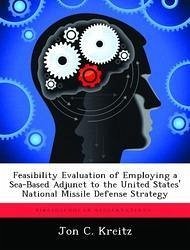Nicht lieferbar

Feasibility Evaluation of Employing a Sea-Based Adjunct to the United States' National Missile Defense Strategy
Versandkostenfrei!
Nicht lieferbar
Germany's development and employment of the V-2 rocket in World War II ushered in a new era in warfare. During the Cold War, mutual assured destruction (MAD) was a key precept of both United States and Soviet Union strategic nuclear deterrence strategies. With the Cold War over, concern over the rapid proliferation of weapons of mass destruction amongst Third World rogue nations and the threat of an accidental or unauthorized ballistic missile attack has overtaken concern for an intentional nuclear attack by the former Soviet Union. Significant congressional legislative efforts have led the De...
Germany's development and employment of the V-2 rocket in World War II ushered in a new era in warfare. During the Cold War, mutual assured destruction (MAD) was a key precept of both United States and Soviet Union strategic nuclear deterrence strategies. With the Cold War over, concern over the rapid proliferation of weapons of mass destruction amongst Third World rogue nations and the threat of an accidental or unauthorized ballistic missile attack has overtaken concern for an intentional nuclear attack by the former Soviet Union. Significant congressional legislative efforts have led the Department of Defense to develop a national missile defense (NMD) strategy employing ground-based interceptor missiles to defend all fifty states from a limited ballistic missile attack. This thesis shows that a sea-based adjunct to a land-based system would be operationally and technically feasible, and it would provide significantly enhanced defensive capabilities over a land-based only NMD system. This study also uses legal treaty interpretation methods to show that the deployment of any NMD system would require modification to or withdrawal from the ABM Treaty. And if the United States decides to pursue modifications to the ABM Treaty, this thesis recommends they include allowances for sea-based NMD systems. This work has been selected by scholars as being culturally important, and is part of the knowledge base of civilization as we know it. This work was reproduced from the original artifact, and remains as true to the original work as possible. Therefore, you will see the original copyright references, library stamps (as most of these works have been housed in our most important libraries around the world), and other notations in the work. This work is in the public domain in the United States of America, and possibly other nations. Within the United States, you may freely copy and distribute this work, as no entity (individual or corporate) has a copyright on the body of the work. As a reproduction of a historical artifact, this work may contain missing or blurred pages, poor pictures, errant marks, etc. Scholars believe, and we concur, that this work is important enough to be preserved, reproduced, and made generally available to the public. We appreciate your support of the preservation process, and thank you for being an important part of keeping this knowledge alive and relevant.








